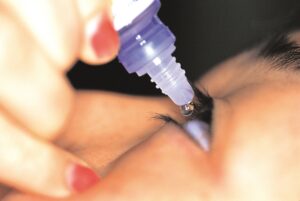Are Pink Eye Drops Safe for Kids?
Your parental instincts kick into high gear when your child wakes up with red, itchy eyes. One common culprit? Conjunctivitis is often known as pink eye. Whether bacteria, viruses, or allergies cause it, pink eye can be a real nuisance for kids and parents scrambling for solutions.
Enter pink eye drops, the go-to remedy for many. But before you squeeze that bottle, it’s natural to wonder: Are these eye drops safe for my little one? After all, their eyes are delicate, and you want to ensure any treatment is gentle yet effective. All of this has you wondering… How can you get rid of a pink eye?
Overview: Understanding Pink Eye Drops for Kids
Pink eye, medically termed conjunctivitis, is a common eye condition among children that can cause discomfort and irritation.
In such situations, pink eye drops often emerge as a frontline solution. These drops come in various formulations, each targeting specific causes and symptoms of conjunctivitis.
Here’s an overview of the different types of pink eye drops for kids:
- Antibiotic Eye Drops:
- These drops are typically prescribed for bacterial conjunctivitis, commonly caused by bacteria like Streptococcus or Staphylococcus. Common ingredients include neomycin, polymyxin B, and bacitracin.
- Antiviral Eye Drops:
- Antiviral eye drops may be recommended if a virus, such as an adenovirus, causes pink eye. However, it’s important to note that most cases of viral conjunctivitis resolve independently without specific treatment.
- Antihistamine Eye Drops:
- Ingredients like ketotifen or olopatadine are commonly found in these drops, offering soothing effects for allergic conjunctivitis.
- Artificial Tears:
- Sometimes, pink eye may not require specific medication but can benefit from lubrication to relieve dryness and discomfort.
- Steroid Eye Drops:
- In cases of severe inflammation associated with allergic or other conjunctivitis, steroid eye drops may be prescribed to reduce swelling and irritation.
Comparing Types of Pink Eye Drops for Kids
As parents, navigating the array of pink eye drops available for kids can be overwhelming. Let’s break down the various kinds of pink eye drops and compare their key features:
| Type of Eye Drops | Purpose | Common Ingredients | Usage |
|---|---|---|---|
| Antibiotic Eye Drops | Treat bacterial conjunctivitis | Neomycin, Polymyxin B, Bacitracin | Apply as directed by the pediatrician |
| Antiviral Eye Drops | Treat viral conjunctivitis | Ganciclovir, Trifluridine, Cidofovir | Apply as directed by the pediatrician |
| Antihistamine Eye Drops | Relieve symptoms of allergic conjunctivitis | Ketotifen, Olopatadine | Apply as directed by the pediatrician |
| Artificial Tears | Provide lubrication and relief for dry eyes | Hypromellose, Polyethylene Glycol | Apply as needed for comfort |
| Steroid Eye Drops | Reduce inflammation associated with severe conjunctivitis | Prednisolone, Dexamethasone | Apply as directed by the pediatrician, with caution due to potential side effects |
Antibiotic Eye Drops: These drops are effective against bacterial conjunctivitis, clearing up the infection by targeting and killing bacteria. A pediatrician usually prescribes them and should be used as directed to ensure proper treatment.
Antiviral Eye Drops: Crafted to tackle viral conjunctivitis head-on, these drops impede the virus’s replication process, thereby mitigating the duration and intensity of symptoms. They’re usually recommended for more acute instances and necessitate meticulous adherence to dosage guidelines.
Antihistamine Eye Drops: Ideal for allergic conjunctivitis, these drops alleviate itching and inflammation caused by allergens. They relieve symptoms but should be used according to the pediatrician’s recommendations to avoid overuse.
Artificial Tears: Lubricating eye drops are suitable for all types of conjunctivitis, offering relief from dryness and discomfort. They can be used throughout the day to keep the eyes moisturized and comfortable.
Steroid Eye Drops: These are reserved for cases of severe inflammation; they reduce swelling and irritation. However, they have potential side effects and should only be used under close medical supervision.
Key Considerations When Choosing Pink Eye Drops for Kids
Selecting the right pink eye drops for your child involves more than just picking a bottle off the shelf. Several factors should be taken into account to ensure both safety and effectiveness. Here are vital considerations to keep in mind:
- Diagnosis by a Pediatrician: Before starting any treatment, it’s crucial to have your child’s pink eye diagnosed by a pediatrician or eye care professional. Determining the underlying cause—bacterial, viral, or allergic—will guide the choice of appropriate eye drops.
- Age Appropriateness: Not all eye drops are suitable for children of all ages. Some formulations may contain ingredients or concentrations not recommended for younger children. Always follow the pediatrician’s advice regarding age-appropriate medications.
- Safety and Side Effects: Each type of eye drop has its own potential side effects. Antibiotic and steroid eye drops, for example, may cause stinging or burning upon application, while antihistamine drops may cause temporary blurred vision. For a detailed breakdown of safe options for your child, refer to our guide on eye drops for kids.
- Frequency and Duration of Use: Understanding how often and for how long the eye drops should be administered is essential for successful treatment. Some drops may need to be applied multiple times daily for a specific duration, while others may only be used as needed for symptom relief.
- Storage and Expiry: Proper storage of eye drops is crucial to maintaining efficacy. Check the label for instructions on storage temperature and shelf life, and discard any expired or contaminated bottles promptly.
- Administration Technique: Proper administration of eye drops is critical to their effectiveness. Different techniques may be required depending on the child’s age and cooperation level.
- Consultation with the Pediatrician: When in doubt, always consult your child’s pediatrician or eye care professional. For a more comprehensive guide, including the importance of eye check-ups, refer to our blog post on why regular eye exams are essential to vision health.
Frequently Asked Questions About Pink Eye Drops for Kids
Are pink eye drops safe for children?
Pink eye drops are generally safe for children as directed by a pediatrician or eye care professional. However, it’s essential to ensure that the drops are age-appropriate and suitable for the child’s condition.
How do I know which type of pink eye drops my child needs?
The selection of pink eye drops suitable for your child hinges on the root cause of their conjunctivitis. Diagnosis and treatment recommendations are best provided by a pediatrician or an eye care specialist.
Can I use over-the-counter eye drops for my child’s pink eye?
Over-the-counter eye drops may temporarily relieve mild cases of pink eye, but they may not be effective against bacterial or viral infections. It’s best to consult with a pediatrician before using any medication, including over-the-counter drops, for your child.

How often should I administer pink eye drops to my child?
The frequency of administration depends on the type of eye drops prescribed and the severity of the pink eye. Follow the pediatrician’s instructions carefully, whether multiple times a day or as needed for symptom relief.
What should I do if my child experiences side effects from pink eye drops?
If your child experiences any adverse reactions, such as stinging, burning, or blurred vision, stop using the drops immediately and consult the pediatrician. They can guide alternative treatments or adjustments to the dosage.
Can I use expired pink eye drops for my child?
It’s not recommended to use expired eye drops for your child, as they may have reduced effectiveness or could potentially cause harm.
Are there any precautions I should take when administering pink eye drops to my child?
Maintain good hygiene by washing your hands before and after giving the drops. Steer clear of touching the dropper tip to prevent contamination, and ensure your child feels at ease to minimize any discomfort during the application process.
Key Takeaways About Pink Eye Drops for Kids:
- Consultation with a Pediatrician is Essential: Before administering any pink eye drops to your child, it’s crucial to consult with a pediatrician or an eye care professional. Healthcare professionals possess the expertise to precisely diagnose the root cause of pink eye and suggest the most suitable treatment, taking into account your child’s age, medical background, and symptom severity. Seeking guidance from a healthcare provider guarantees personalized care and tailored treatment for your child’s specific needs.
- Understanding Different Types of Eye Drops: Pink eye drops are available in different formulations, each tailored to address specific causes and symptoms of conjunctivitis. Antibiotic drops are adept at combating bacterial infections, while antiviral variants target viral conjunctivitis. Antihistamine drops alleviate allergic reactions, and artificial tears provide lubrication for dry eyes. In cases of severe inflammation, steroid drops may be prescribed, although they warrant close medical monitoring due to potential side effects. Familiarizing oneself with these distinctions enables parents to make informed choices concerning their child’s ocular well-being.
- Proper Administration and Monitoring: Ensuring the proper administration of pink eye drops is paramount for their efficacy and safety. Adhere closely to the pediatrician’s guidelines, administering the drops at the prescribed dosage and frequency. Prioritize hygiene by washing your hands before and after giving the drops, and refrain from touching the dropper tip to avert contamination. Remain vigilant for any adverse reactions or side effects in your child, such as stinging, burning, or blurred vision, and promptly consult the pediatrician if any concerns emerge. Furthermore, stay mindful of the expiration date of the eye drops, discarding any expired or compromised bottles without delay.
Conclusion: Supporting Your Child’s Eye Health

As parents, safeguarding our children’s health is paramount. When it comes to eye issues like pink eye, knowledge and proactive care are essential. In this guide, we’ve explored the world of pink eye drops for kids, delving into their types, considerations, and administration.
Navigating through the various types of eye drops—from antibiotics to antihistamines—can be daunting, but armed with information, you can make informed decisions alongside healthcare professionals. Remember, consultation with a pediatrician is crucial for accurate diagnosis and personalized treatment recommendations.
Understanding the nuances of each type of eye drop empowers you to choose the most suitable option for your child’s condition. Whether it’s combating bacteria, soothing allergies, or simply lubricating dry eyes, the right eye drops can significantly affect your child’s comfort and recovery.
Additionally, proper administration techniques, including hygiene practices and monitoring for adverse reactions, ensure the safety and efficacy of treatment. Following these guidelines and staying vigilant can support your child’s eye health and facilitate a swift resolution of pink eye symptoms.
In closing, prioritize your child’s well-being, and don’t hesitate to contact healthcare professionals for guidance and support. With proactive care and attention, you can help your child overcome pink eye and return to their bright-eyed best.
***************
To ensure your eyes and those of your family receive the best care, consider these trusted products from our affiliate partners. Click on the links below to explore and purchase high-quality eye care solutions.
- Zenni Optical: Looking for stylish frames that won’t break the bank? Look no further. PLUS, use EYEFATIGUE12 for an additional 12% off!
- Clear Crystal Vision: Enhance your vision clarity and support overall eye health. This all-natural supplement is designed to nourish and protect your eyes from daily strain.
- EyeFortin: A premium eye care supplement to support overall eye health.
- Claritox: Vertigo getting you down? Tired of feeling off-balance after staring at screens all day? Claritox Pro’s natural formula may help you regain your equilibrium and enjoy life without dizziness holding you back.
- 1-800-Contacts: If you wear contacts, receive the exact same lenses your doctor prescribed, delivered straight to your door, at the best price.
- Eye Floater Pellets: Discover the homeopathic secret to clearer vision. We found it on Amazon and you can too!
- Nature’s Bounty Store: For all of your vitamin and supplement needs!
